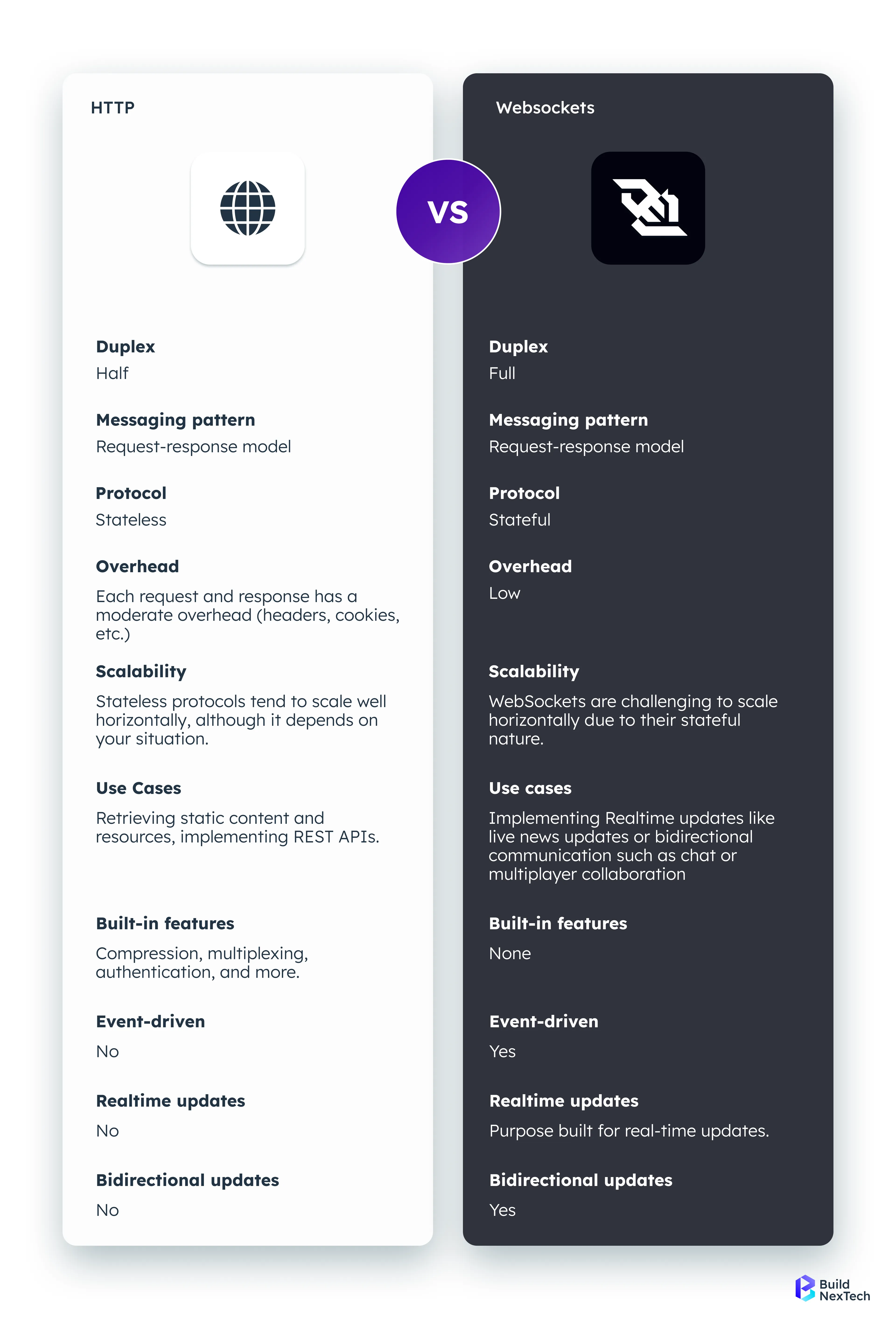With the increasing demand for real-time data and interactive experiences, choosing the right communication protocol is critical. Whether you're building chat apps, online games, or financial platforms, understanding the differences between WebSocket and HTTP is key to smarter architecture decisions.
What’s ahead? Keep reading for:
🚀 Fundamentals of HTTP and WebSocket protocols
🚀 Pros and cons for real-time, bidirectional communication
🚀 Performance and security comparisons in live apps
🚀 WebSocket vs. HTTP ideal use scenarios
🚀 Expert recommendations on client-server models and network traffic
Introduction to Web Communication Protocols
Web communication protocols form the backbone of every modern client-server network, enabling smooth interaction between users and applications. For web app developers near me, understanding these protocols is vital.
- HTTP manages standard request-response cycles between clients and servers.
- WebSocket enables real-time data exchange, perfect for real-time web app development.
- The client server runtime process governs how data flows during each interaction.
- Differentiating server side vs client side processes ensures efficient app performance.
Mastering these protocols helps developers build responsive, scalable apps that enhance user experience and real-time communication.
What Is HTTP and How Does It Work?
HTTP (Hypertext Transfer Protocol) is a stateless protocol commonly used in web development. It’s essential for delivering static content, REST APIs, and cacheable resources efficiently.

- HTTP follows a request-response protocol model, ideal for traditional web applications, e-commerce websites, and static resource delivery.
- It operates over a single HTTP connection that opens and closes with each request, making it unidirectional.
- Due to its stateless nature, HTTP doesn’t maintain persistent connections or allow frequent updates unless polled periodically.
- Understanding HTTP status codes like HTTP 400, HTTP 401, HTTP error 500, and HTTP error 503 is vital for diagnosing client-server issues.
- HTTP is compatible with HTTPS, the protocol's secure variant.
- Developers often use a Python HTTP server to simulate server behavior locally and explore what HTTP is more deeply.
With its simplicity and versatility, HTTP remains a core protocol in web development, and knowing its features helps developers build better and more secure applications.
What Is WebSocket? A Modern Approach to Real-Time Communication
WebSocket is a communication protocol designed for real-time, bidirectional data exchange between client and server over a single, persistent connection.
- Enables real-time, bidirectional communication with instant updates and continuous connection.
- Unlike HTTP’s request-response model, WebSocket supports two-way communication, ideal for chat apps, financial trading platforms, and online games.
- Development is simplified using tools like FastAPI WebSocket, React WebSocket, and Python WebSocket client.
- Other implementations include OBS WebSocket for live streaming and SSH WebSocket for tunneling.
WebSocket’s bidirectional nature makes it essential for building responsive, real-time web applications that demand continuous data flow.
H2 - Key Differences Between HTTP and WebSocket Protocols
Understanding the differences between HTTP and WebSocket is crucial for choosing the right protocol for your application. While both are essential for client-server interactions, they differ significantly in how they manage connections and handle data transfer. Here's a breakdown of the key distinctions between these two protocols:

These key differences directly affect how client-server communication is handled in real-time messaging, interactive features, and frequent communication applications.
Advantages and Disadvantages of WebSocket and HTTP for Real-Time Web Apps
Choosing the right communication protocol is crucial for your web app’s performance and real-time needs. Here’s a quick comparison between HTTP and WebSocket to guide your decision.
For traditional apps with static content, HTTP is ideal. However, for real-time applications like chat, online gaming, or live updates, WebSocket’s persistent, low-latency connection is the better choice.
Performance Comparison: WebSocket vs HTTP in Real-Time Scenarios
When it comes to Performance Comparison, WebSocket often outshines HTTP in real-time scenarios. With persistent connections and efficient data exchange, it reduces server load and network traffic, especially in apps requiring frequent updates and real-time data transfer like Multiplayer games and chat applications.
In contrast, HTTP's request-response model creates overhead due to repeated client-server runtime processes, making it unsuitable for real-time interactions.
Security Considerations for WebSocket and HTTP
Security is a critical aspect of client server architecture and communication protocols like HTTP and WebSocket, especially when considering client side vs server side security responsibilities.
- HTTPS enhances HTTP by adding encryption and security features, ensuring content type and source code integrity.
- The difference between HTTP and HTTPS lies mainly in the secure transmission enabled by HTTPS.
- For WebSocket, the wss:// protocol secures communication through encryption.
- Unlike HTTP/HTTPS, WebSocket requires developers to manually manage authentication, authorization, and data validation.
Understanding the security differences between HTTP/HTTPS and WebSocket is vital for developers to protect data and maintain trust in their applications.

Scalability in WebSocket vs HTTP-Based Applications
In a client-server architecture, both HTTP and WebSocket play important roles, each with unique strengths and challenges in scalability and connection management.
- By separating server-side and client-side tasks, HTTP scales effectively and manages static resources and infrequent updates.
- Wide compatibility and simple scaling are supported by the standard HTTP port (80 for HTTP and 443 for HTTPS).
- WebSocket excels in real-time applications but demands careful management of active connections and server resources.
- Comparing WebRTC vs WebSocket helps determine the best protocol for peer-to-peer or client-server real-time communication.
- The HTTPS vs HTTP difference is crucial for secure data transmission in scalable web app development.
Choosing between HTTP and WebSocket depends on the application needs, balancing scalability, security, and real-time data requirements in modern web development.
Ideal Use Cases for HTTP and WebSocket Protocols
- Use HTTP for: static content, what app web, web and app activity, web app development company websites, and e-commerce platforms.
- Use WebSocket for: real-time messaging, peer connection, news updates, collaborative tools, and interactive experiences like online multiplayer games and financial trading platforms.
The choice of applications depends on the required communication models and real-time update frequency.
Browser Support and Compatibility for WebSocket and HTTP
Browser support and compatibility play a key role in determining the effectiveness of WebSocket and HTTP for your web app.
- HTTP:
- Supported by all modern browsers
- Works well for traditional, static content
- Universal compatibility with minimal restrictions
- WebSocket:
- Supported by all modern browsers, but may face issues in legacy systems or strict firewalls
- Enables bidirectional, real-time communication
- Often includes features like automatic reconnection after a dropped connection
Platforms like WhatsApp Web leverage WebSocket for seamless two-way communication, making it ideal for real-time web apps. Understanding concepts like WebSocket vs HTTP and HTTP response codes can help optimize both performance and user experience.
Developer Tools and Libraries for HTTP and WebSocket
Developers can leverage a variety of tools tailored for HTTP and WebSocket to build powerful real-time applications. From REST APIs and Python HTTP servers to FastAPI WebSocket and OBS WebSocket, these tools enable bidirectional communication and low-latency performance.
- For HTTP: REST API, python http server, and browser dev tools.
- For WebSocket: fastapi websocket, react websocket, python websocket, python websocket client, and even obs websocket for streaming use cases.
These tools help build real-time applications with features like bidirectional message handling and low-latency communication.
Choosing the Right Protocol for Your Web Application
Your decision between WebSocket vs HTTP should be based on your app’s needs:
- Choose HTTP for web app development involving static content or cacheable resources with infrequent updates. HTTP uses standard request methods and is ideal when communication between clients occurs through separate request-response cycles over a single connection.
- Choose WebSocket for real-time interactions, frequent communication, and constant updates where real-time two-way communication through full-duplex communication channels and a two-way communication channel is essential. WebSocket allows for constant data flow by keeping the client and server connected.
Think about how the architecture in general and the communications protocol selection will be impacted by client vs. server, client-server paradigm, and server-to-client dynamics.
Recap
In this blog, we compared WebSocket and HTTP, focusing on their communication models, performance, and best use cases for real-time applications. We also touched on WebRTC vs WebSocket to highlight different real-time communication needs.
WebSocket enables a persistent TCP connection and a duplex connection, allowing persistent, bidirectional communication, making it ideal for chat apps, online games, and financial platforms. It starts with an initial connection handshake and often uses Transport Layer Security to ensure security features are maintained.
HTTP, with its request-response model and various HTTP response messages and codes, suits static content and traditional web apps.
Choosing the right protocol depends on your app's need for real-time updates, low latency, and efficient data exchange, all of which impact overall user experience.
People Also Ask
Can WebSocket and HTTP be used together in the same application?
Yes, many web apps use HTTP for static content and REST APIs, while using WebSocket for real-time features like chat or notifications.
Is WebSocket more expensive to implement than HTTP?
Generally, yes. WebSocket requires more complex server-side handling and long-lived connections, which can increase infrastructure and maintenance costs.
Does using WebSocket affect SEO or web crawlers?
WebSocket does not impact SEO directly, as search engine crawlers primarily index HTTP-based static content. WebSocket content is not crawlable.
Is there a risk of memory leaks with WebSocket connections?
Yes, if WebSocket connections aren’t properly closed or managed, they can cause memory leaks and affect server performance over time.


























.webp)
.webp)
.webp)

